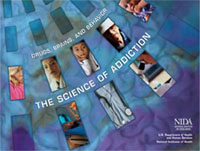Topics in Brief: Drugs, Brains, and Behavior: The Science of Addiction
Revised January 2007
 Many people today do not understand why individuals become addicted to drugs, or how drugs change the brain to foster compulsive drug abuse. This new NIDA booklet aims to fill that knowledge gap by providing scientific information about the disease of drug addiction, including the many harmful consequences and basic approaches to prevent and treat the disease. View the Science of Addiction Booklet.
Many people today do not understand why individuals become addicted to drugs, or how drugs change the brain to foster compulsive drug abuse. This new NIDA booklet aims to fill that knowledge gap by providing scientific information about the disease of drug addiction, including the many harmful consequences and basic approaches to prevent and treat the disease. View the Science of Addiction Booklet.Is drug addiction a disease?
Yes. Addiction is a chronic, relapsing disease that affects the brain and causes compulsive drug seeking and use despite harmful consequences.
- How is addiction a disease? Addiction is considered a brain disease because drugs change the brain—in structure and in function. It's true that for most people, the initial decision to take drugs is voluntary. Over time, however, drug abuse can cause changes to the brain that erode a person's self control and ability to make sound decisions, while sending intense impulses to take drugs.
- What is its course? Drug addiction is a chronic, relapsing disease—like diabetes, asthma, or heart disease—and it can be managed successfully. Treatment helps people to counteract addiction's powerful disruptive effects and regain control of their lives. And just as with other chronic diseases, relapses are not uncommon. But relapse does not signal failure—rather, it indicates that treatment should be reinstated or adjusted to help the addict fully recover.
Why do some people become addicted, while others do not?
No single factor can predict whether or not a person will become addicted to drugs. Risk for addiction is influenced by a person's biology, social environment, and development. The more risk factors an individual has, the greater the chance that taking drugs can lead to addiction. For example:
- Biology. The genes that people are born with– in combination with environmental influences– account for about half of their addiction vulnerability. Additionally, gender, ethnicity, and the presence of mental disorders may influence risk for drug abuse and addiction.
- Environment. A person's environment includes many different influences– from family and friends to socioeconomic status and quality of life in general. Factors such as peer pressure, physical and sexual abuse, stress, and parental involvement can greatly influence the course of drug abuse and addiction in a person's life.
- Development. Genetic and environmental factors interact with critical developmental stages in a person's life to affect addiction vulnerability– with adolescents experiencing a double threat. Although taking drugs at any age can lead to addiction, the earlier drug use begins, the more likely it is to progress to more serious abuse. And because adolescents' brains are still developing in the areas that govern decisionmaking, judgment, and self-control, they are especially prone to risk-taking behaviors, including trying drugs of abuse.
How do drugs work in the brain?
Drugs tap into the brain's communication system and disrupt the way nerve cells normally send, receive, and process information. Drugs work in the brain by:
- Imitating natural neurotransmitters (chemical messengers in the brain). Because of the similarity in chemical structure between drugs and neurotransmitters naturally produced by the brain, some drugs, such as marijuana and heroin, are able to "fool" the brain's receptors and activate nerve cells to send abnormal messages via the network.
- Overstimulating the reward system by flooding the circuit with dopamine. Dopamine is a neurotransmitter present in regions of the brain that regulate movement, emotion, motivation, and feelings of pleasure. And nearly all drugs of abuse, directly or indirectly, activate this system. Some drugs, particularly stimulants like methamphetamine and cocaine, cause nerve cells to release abnormally large amounts of natural neurotransmitters or prevent their normal recycling, which is needed to shut off the signal between neurons.
What happens to your brain if you keep taking drugs?
- The brain adapts. In response to the overwhelming surges in dopamine, the brain adjusts by decreasing the number of dopamine receptors available– thus diminishing the function of the reward circuit. Drug addicts are compelled to abuse drugs to bring their dopamine function back up to normal, requiring ever larger amounts to achieve the initial dopamine high– an effect known as tolerance.
- Changes in neurotransmitters other than dopamine. Long-term abuse causes changes in other brain chemical systems, including glutamate, a neurotransmitter that influences the reward circuit and the ability to learn. When the optimal concentration of glutamate is altered by drug abuse, the brain attempts to compensate, which can cause impairment in cognitive function.
- Drug abuse can trigger nonconscious memory systems. Conditioning is one example of this type of learning, whereby environmental cues, such as certain people or places, become associated with the drug experience and can trigger uncontrollable cravings if the individual is exposed to these cues, even without the drug itself being available.
- Addiction. Brain imaging studies of drug-addicted individuals show changes in areas of the brain that are critical to judgment, decisionmaking, learning and memory, and behavior control. These changes are likely what drive an abuser to seek out and take drugs compulsively despite adverse consequences.
Can addiction be treated successfully?
Yes. Research shows that combining addiction treatment medications, where available, with behavioral therapy is the best way to ensure success for most patients. Treatment approaches that are tailored to address each patient's drug abuse patterns and co-occurring medical, psychiatric, and social problems can lead to sustained recovery and a life without drug abuse.


